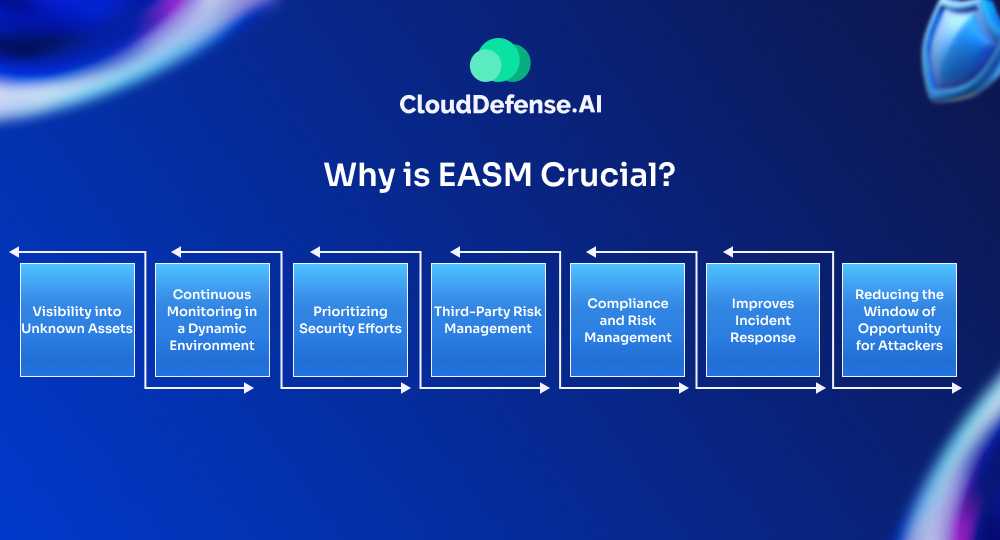What is an Attack Surface?
First, let’s discuss what an attack surface is before we dive into EASM.
The attack surface is basically all the ways an attacker could get into your systems. It’s at every point where someone unauthorized might be able to access or extract data from your network. This includes things like:
- Websites and web applications
- APIs
- Cloud services
- Internet-connected devices
- Employee accounts and emails
- Third-party vendors with access to your systems
Think of it as all the doors and windows to your digital network. Some are obvious, some are hidden, and some you might not even know exist. The bigger your organization, the more complex your attack surface usually is.
What Is External Attack Surface Management (EASM)?
External Attack Surface Management (EASM) is the process of identifying, monitoring, and managing the external-facing assets and vulnerabilities of an organization. This includes any system, service, or device exposed to the public internet—basically, the parts of your infrastructure that attackers can target.
What EASM Does:
- Maps your external attack surface: Identifies all assets connected to the internet, from websites to APIs, to services.
- Monitors for new vulnerabilities: Continuously scans for weaknesses and misconfigurations in external-facing systems.
- Identifies unknown assets: Finds assets you may have missed or forgotten about, including legacy systems and shadow IT.
- Prioritizes risks: Helps you focus on the most critical threats, based on exposure and potential damage.
- Automates asset discovery: Uses tools to continuously detect new assets and monitor their security posture.
Why is EASM Crucial?
According to Verizon’s latest data breach report, 70% of attacks are coming from external threats. That’s not a small number. These attackers target weaknesses companies don’t always see or protect—those areas you might think are safe, but actually aren’t.
So, why is EASM such a game-changer? It’s simple: EASM gives you a clear, up-to-date view of everything exposed to the outside world, so you can stay ahead. Here’s how it helps:
- Find shadow IT and forgotten assets: These are the things you might not even know exist—old devices, services, or apps that could be an open door for attackers.
- Spot vulnerabilities and misconfigurations: EASM helps you catch weak spots before anyone can take advantage of them.
- Understand and prioritize risks: Not all vulnerabilities are equal. EASM lets you know what’s critical, so you can tackle the big problems first.
- Take action on security gaps: Once you know what needs fixing, you can close those gaps quickly and effectively.
- Stay compliant: Whether it’s legal regulations or industry standards, EASM helps you stay on track with your security obligations.
Thus, by providing a holistic view of an organization’s external attack surface, EASM helps businesses proactively address security gaps and reduce their overall risk of cyber attacks.
How Does EASM Work?
EASM is about visibility. It works by constantly scanning your organization’s external assets—domains, IP addresses, web applications, and cloud services. You might think you have everything under control, but a lot of these assets could be unknown to you because of shadow IT, third-party services, or simple misconfigurations.
EASM doesn’t wait for you to spot the issues—it does the work for you. It uses automated tools like reconnaissance and scanning to map out everything that could be a potential entry point for attackers. Here’s what happens next:
What EASM Actually Does:
- Discovers Assets: It scans the internet for all your external-facing assets, including ones you didn’t know about, or that weren’t properly documented.
- Assesses Vulnerabilities: Once it finds your assets, it checks them for weaknesses—like outdated software, poor configurations, or missed security updates.
- Prioritizes Risks: EASM doesn’t overwhelm you with every little issue. It ranks vulnerabilities by how severe they are, so you focus on the things that matter most.
- Monitors Continuously: EASM is not a one-and-done thing. It keeps watching your attack surface in real-time, alerting you to any changes or new risks, so you’re always aware.
In the end, EASM helps you stay on top of your external attack surface. You get a clear, continuous view of potential vulnerabilities, and the system makes sure you’re acting on the ones that matter. It’s about simplifying the complexity and being proactive—because ignoring your attack surface is a risk you can’t afford to take.
Different Between Internal vs External Attack Surface Management
When it comes to securing your organization, understanding the difference between internal and external attack surface management is key. These two are not the same, but both are critical to minimizing risk. Here’s a breakdown:
Internal Attack Surface Management
This is all about what’s going on inside your network. It’s the stuff behind your firewall, the systems and data that (in theory) only your employees and authorized users can access. Here’s what it typically covers:
- Internal networks and servers
- Employee workstations and devices
- On-premises applications
- Data storage systems
- User accounts and permissions
The goal here is to lock down your internal systems, making sure there are no weak spots that an attacker could exploit if they managed to get inside your network. It’s about things like:
- Making sure all your internal systems are patched and up-to-date
- Monitoring user behavior for anything suspicious
- Controlling access to sensitive data
- Securing internal communications
External Attack Surface Management
This is what we’ve been talking about—it’s all about your public-facing assets. Anything that’s connected to the internet and could potentially be accessed by someone outside your organization. This includes:
- Websites and web applications
- Public-facing APIs
- Cloud services
- Internet-connected devices
- Email servers
- Anything else that’s visible from the outside
EASM is focused on finding and securing all these external touchpoints. It’s about discovering assets you might not even know you have, and making sure they’re not leaving you open to attack.
Here’s a clear comparison in table format:
|
Aspect |
External Attack Surface Management (EASM) |
Internal Attack Surface Management (IASM) |
|
Focus |
Everything outside the organization: domains, IPs, web apps, third-party services |
Everything inside the organization: servers, databases, internal networks, user access |
|
Visibility |
Exposed to the outside world and vulnerable to external threats |
Less exposed, but still vulnerable once an attacker breaches the perimeter |
|
Risk Focus |
Prevents external attackers from exploiting external-facing assets |
Prevents unauthorized internal access and limits damage from attackers who’ve breached external defenses |
|
Exposure Level |
High exposure due to external accessibility |
Lower exposure, but once compromised, can lead to significant damage internally |
|
Main Goal |
Monitor and secure external-facing assets to reduce exposure to hackers |
Monitor and secure internal systems to limit lateral movement of attackers |
|
Type of Threats |
External threats, such as hackers, DDoS attacks, and phishing |
Internal threats, such as insider attacks or post-breach lateral movement |
|
Example Assets |
Public domains, IP addresses, cloud services, web applications |
Internal networks, servers, sensitive databases, access controls |
|
Why It Matters |
It’s crucial because attackers often target external-facing systems to breach the network |
It’s essential because once an attacker is inside, internal systems are where they do the most damage |
Why You Need Both
Here’s the thing—you can’t just focus on one or the other. A solid security strategy needs both. Attacks often involve multiple stages. An attacker might use a vulnerability in your external attack surface to gain a foothold, then exploit weaknesses in your internal systems to move around and access sensitive data.
Hence, by managing both your internal and external attack surfaces, you’re creating a more comprehensive defense. It’s about securing your perimeter and your core, giving attackers fewer opportunities to cause harm.
Benefits of EASM

Visibility into Unknown Assets
You can’t protect what you don’t know about. That’s the core problem EASM solves. As companies grow, merge, or adapt to new technologies, they often lose track of some of their digital assets. Maybe it’s an old server someone forgot to decommission, or a dev environment that accidentally went live. EASM helps you find these forgotten or unknown assets before attackers do.
Continuous Monitoring in a Dynamic Environment
The internet doesn’t stand still, and neither does your attack surface. New vulnerabilities pop up daily, and your digital footprint is constantly changing. EASM provides ongoing monitoring, alerting you to new risks as they appear. This real-time insight is crucial in a world where a single unpatched vulnerability can lead to a major breach.
Prioritizing Security Efforts
Let’s face it, most security teams are stretched thin. They need to focus their efforts where it matters most. EASM helps by identifying your most critical and exposed assets, allowing you to prioritize your security efforts and resources more effectively.
Third-Party Risk Management
Your security is only as strong as your weakest link, and often that link is a third-party vendor or partner. EASM can help you understand the risks associated with your external connections, giving you a clearer picture of your overall security posture.
Compliance and Risk Management
Many industries have strict rules about data protection and cybersecurity. EASM gives you the visibility you need to prove you’re meeting these standards. It can also help you spot compliance issues before they become problems during an audit.
Improves Incident Response
When something does go wrong, EASM gives you a head start. You’ll have a clear map of your entire attack surface, making it easier to trace how an attacker got in and what they might have accessed. This can dramatically speed up your response time and limit the damage.
Reducing the Window of Opportunity for Attackers
Since it can continuously scan for and address vulnerabilities, EASM significantly reduces the time that weaknesses are exposed. This narrows the window of opportunity for attackers, making it much harder for them to find and exploit vulnerabilities in your systems.
Challenges in External Attack Surface Management (EASM)
Managing your external attack surface is essential, but it’s not easy. If you’ve been trying to get a grip on your digital assets, you probably already know that it’s messy and constantly changing. Let’s look into the biggest challenges:
1. Constant Changes
As your company grows or shifts to new technologies, your attack surface evolves. The problem? It’s tough to keep track of everything. New assets, services, and vulnerabilities appear out of nowhere. And some slip through the cracks unnoticed. If you’re not actively tracking these changes, you’ll miss critical gaps that attackers can exploit.
2. Alert Overload
EASM tools can be great at finding issues, but they also create a ton of noise. The issue here is not all alerts are equally urgent or actionable. Sorting through tons of alerts to find the actual threats can waste time, energy, and resources. Eventually, you might ignore some, which is exactly what attackers are hoping for.
3. Making Data Useful:
EASM gives you a lot of data, but the real challenge is turning that data into something useful. You need to integrate EASM findings into your risk management process, which is where a lot of companies fail. If you can’t connect the dots and align EASM data with your overall business goals, you’re not managing risk effectively.
4. Shadow IT and Unmanaged Assets:
A lot of companies have assets they don’t even know about. Employees sign up for services or create accounts that never get logged. These “hidden” assets are huge blind spots in your security—and attackers know how to find them.
5. Data Overload and Prioritization:
EASM tools generate a lot of data. A lot. The problem is, it’s hard to know which vulnerabilities need attention first. Security teams can end up wasting time on issues that don’t matter while ignoring the ones that actually pose a serious threat. Prioritizing the right vulnerabilities is a skill and a strategy that most companies haven’t figured out.
EASM is vital, but it’s a challenge to get right. Without the right tools and processes in place, you’re just creating noise. To make it work, you need to stay ahead of changes, make the data actionable, and focus on what matters most. Otherwise, the attackers will.
Conclusion
Every exposed asset is a potential entry point for a cyberattack, putting your data, reputation, and even financial stability at risk. Hackers are constantly searching for weaknesses, and with the ever-expanding digital landscape, even a single exposed asset can be your downfall. Legacy security measures just can’t keep up.
EASM is your chance to take control, identify those hidden vulnerabilities, and eliminate them before attackers do. It’s the proactive defense you need in today’s relentless threat landscape. Don’t wait for a breach to be your wake-up call. Take action today and secure your organization’s digital perimeter with EASM.







